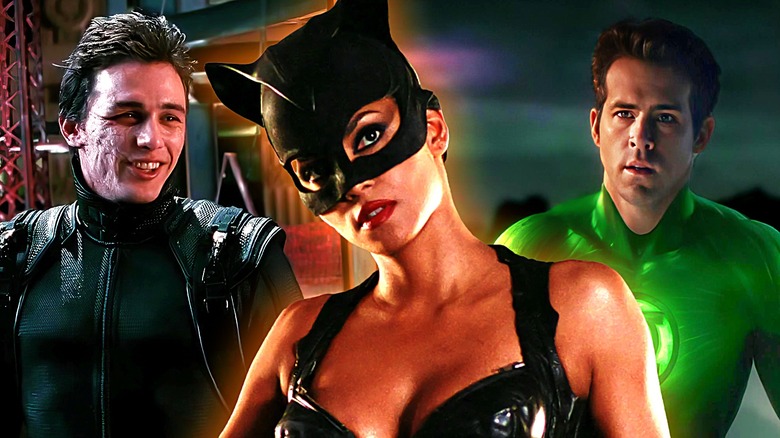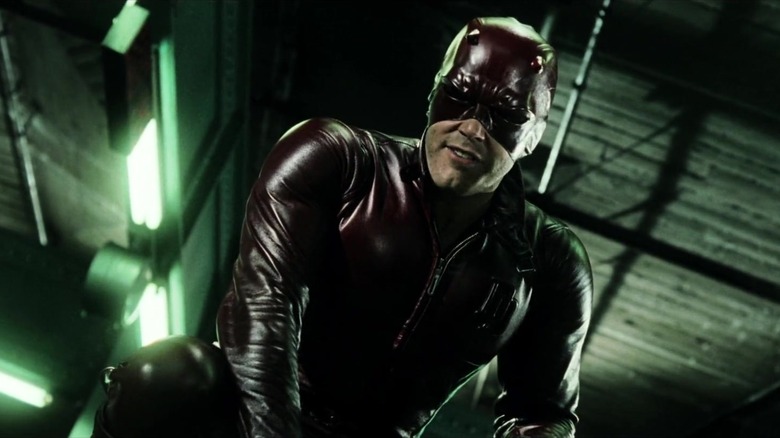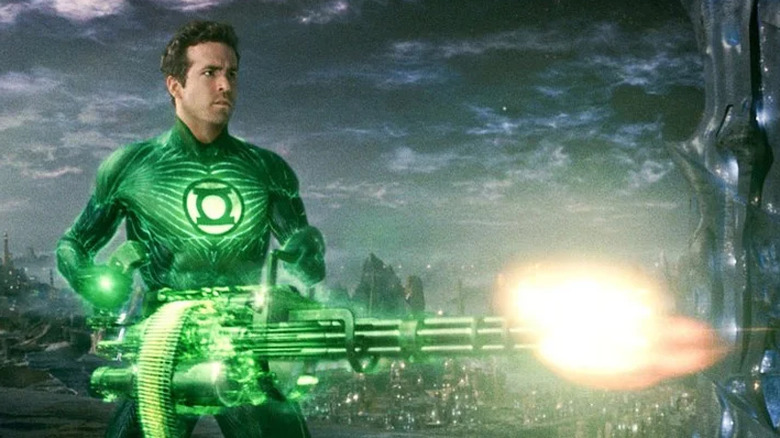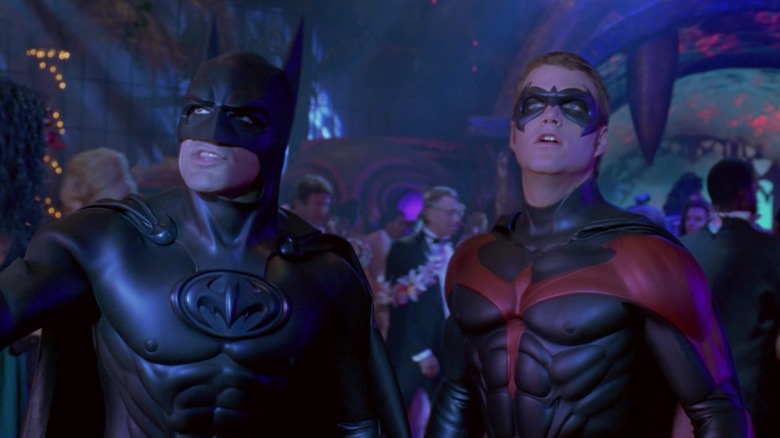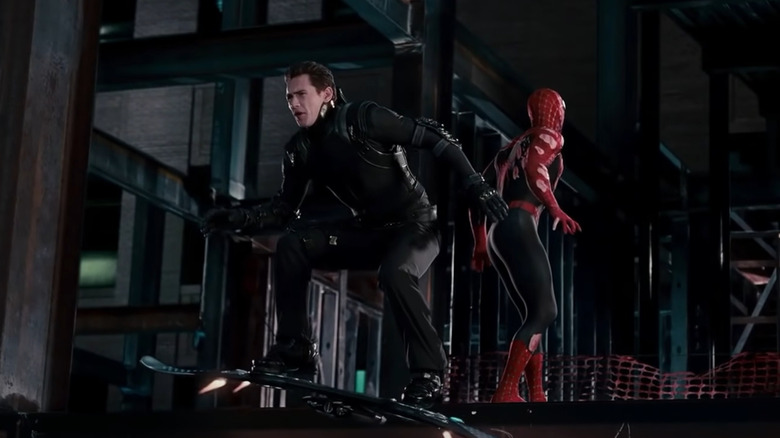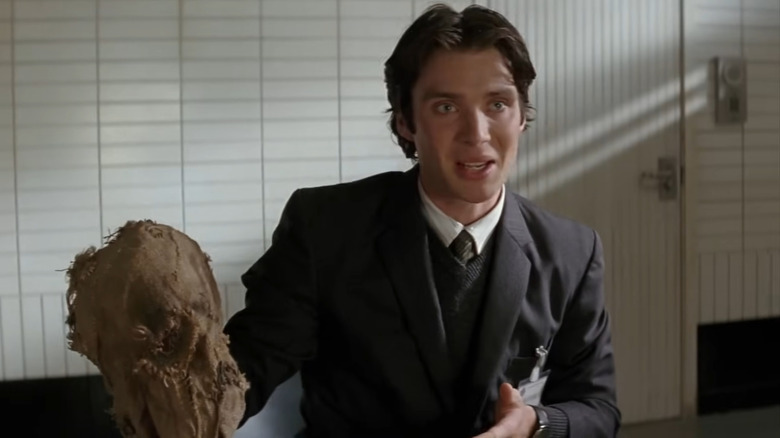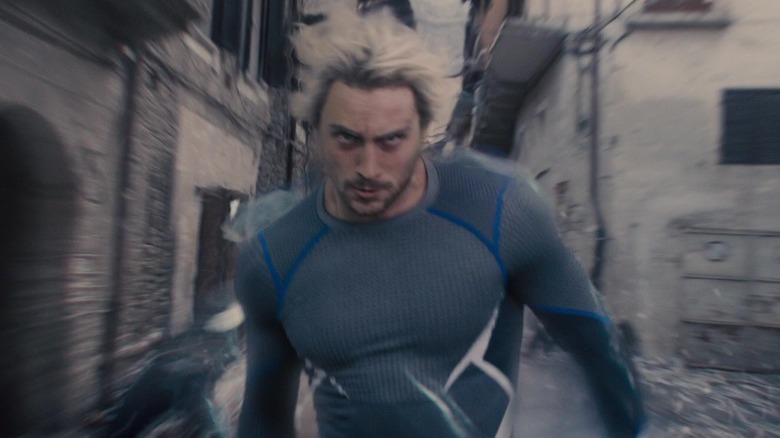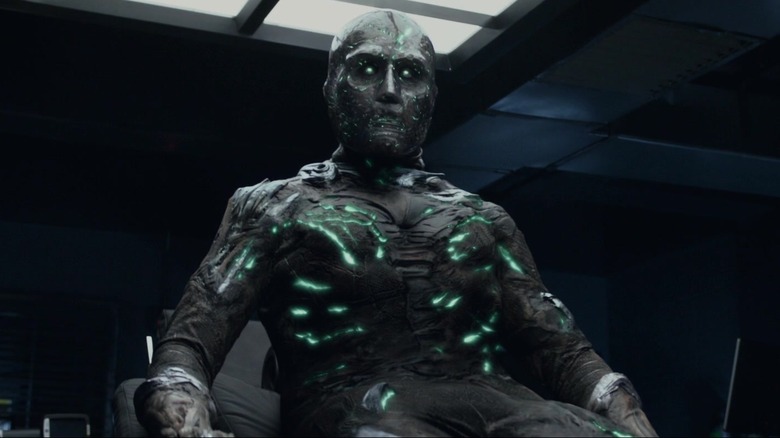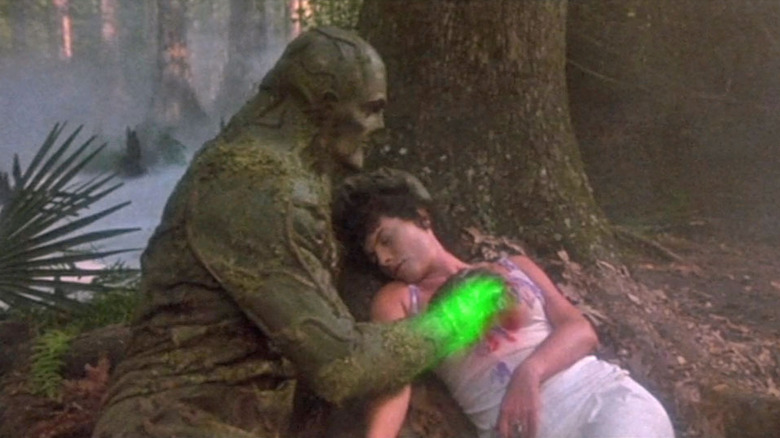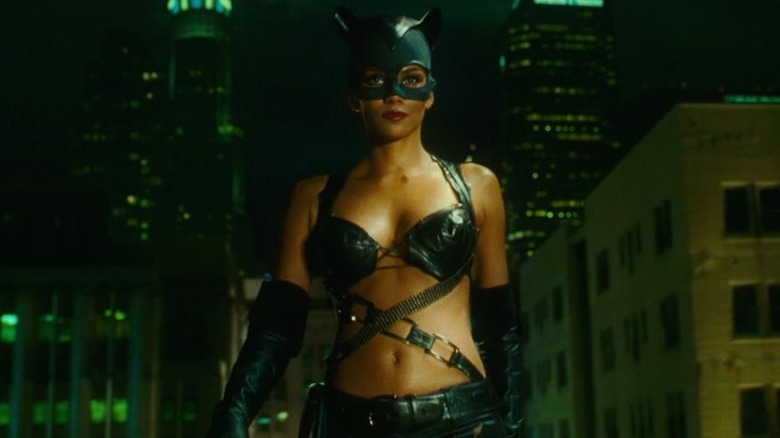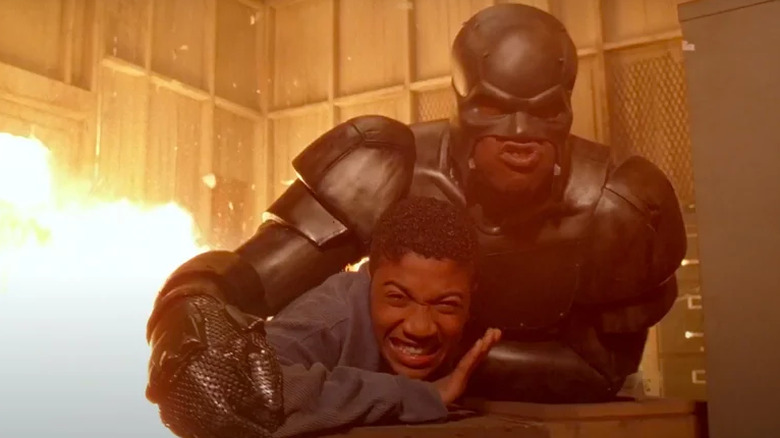The 10 Worst Superhero Movie Costumes Of All Time
It's pretty obvious that comic book fans are spoiled by movies today. Superhero cinema is so ubiquitous that every major director and star gets asked about them on a regular basis, and in general, even the bad ones make for pretty decent films. Executives today actually grew up with these characters and care about seeing them done right — and part of that is getting the costumes up to cinematic speed. Spandex looks silly, and muscle suits often look fake, but movies are no longer so embarrassed about superhero palettes that they have to make everything black. (Indeed, Spider-Man's all-black "Night Monkey" suit in "Far From Home" feels like a deliberate dig at such things.)
It was not always thus. Just over a couple decades ago, studios were still actively blowing it in a big way when it came to superhero fashions. And we're not just talking about how Michael Keaton's jeans as Bruce Wayne in the 1989 "Batman" make his butt look terrible, like he pissed off the wardrobe department. We're talking about the actual superhero suits that filmmakers signed off on to actually appear onscreen, even as they made the heroes look ridiculous rather than intimidating or heroic. Simple prosthetics, like Ryan Reynolds' infamous Deadpool-in-name-only Weapon XI face and chest makeup in "X-Men Origins: Wolverine," don't count, but villain costumes do.
So, without further ado, let's dive deep into some really bad wardrobe. Here are the 10 worst movie superhero costumes of all time.
Daredevil (2003)
Giving some credit where it's due, Ben Affleck's Daredevil suit isn't actually the worst one ever worn on camera — that would be Rex Smith's black blindfold and body stocking combo in the 1989 TV movie "The Trial of the Incredible Hulk." Affleck, however, had the misfortune in 2003 to be caught in a transitional phase of cinematic superhero costuming. The era of the Batman/Flash muscle suit was over, the leather jacket/Matrix/Blade look had taken over, and despite the success of Sam Raimi's "Spider-Man" in 2002, movie executives weren't yet sure how fans would take to vivid hues. Even the X-Men confined their signature shades to minor piping details on otherwise black outfits.
The red leather outfit the film ended up using feels like the wardrobe equivalent of an actor who won't commit. It's not quite a muscle suit, nor exactly realistic biker gear. It isn't convincingly tactical, and why make it red if it's going to be a dark, muddy red designed not to be seen very well? That said, even though fans do make fun of the movie and the suit, Affleck's commitment to the role, in combination with wire-fu expert Cheung-yan Yuen's fight choreography, mitigated the damage.
At least, years later, everyone got redemption: Daredevil with a tactical armor suit for actor Charlie Cox that had the right amount of comic-book style for the Netflix series, and Affleck delivering a standout grimdark superhero performance in a comic-accurate Batsuit for Zack Snyder's "Batman v Superman: Dawn of Justice."
Hal Jordan (Green Lantern)
Green Lantern's costume is inherently goofy. It's the uniform of a galactic police force, meant to stand out, utilizing the color green and the power of a lantern for...reasons. The Green Lantern Corps use their power rings and minds to create constructs that briefly aid them in active duty before disappearing, like hard-light holograms. Their costumes, however, shouldn't be constructs too. If they were, all it would take to make a Green Lantern suddenly naked is a little distraction.
Thus, the decision to make Ryan Reynolds' Lantern uniform for Hal Jordan mainly CG feels, and looks, like the wrong approach. Unlike the giant fists he makes with the ring, it's supposed, in canon, to be a tangible outfit. CG at best can look good enough to stay timeless; at worst, it will age badly. It never starts to look better as years go by. Guess which category "Green Lantern" falls into?
On the whole, the movie's not as bad as people say; it's just more oriented towards kids with a simpler story than audiences had become used to by 2011, with the Marvel Cinematic Universe in full swing — something Reynolds finally, officially entered in 2024 as Deadpool. Reynolds himself mocks his tenure in the green suit more than anybody, having Deadpool shoot him in the head during the "Deadpool 2" end credits to retroactively prevent him from taking the role. He could have just negotiated a better costume, though.
Batman & Robin (Batman & Robin)
Most parents have had the experience of telling their kid that what they want to wear in public isn't appropriate and that they need to change. Apparently, George Clooney's Bruce Wayne never learned this important lesson.
Batman is supposed to be Robin's (adopted) dad. Where does he get of letting Dick Grayson (Chris O'Donnell) go out looking like he wants to go to a dungeon and get whipped? Well, let's just say he has no room to talk, with his own goofy blue nipples and ears that bounce as he does that signature Clooney head bob. Granted, Chris O'Donnell was a grown-ass adult in "Batman and Robin," but Robin in comics is typically a teenager. Anyone who knows that felt a weird disconnect seeing him in the halfway-to-Nightwing rubber suit that's an uncomfortable mix of infantilization and hard-R.
The first Batman suit with nipples, in "Batman Forever," almost worked. It gave Batman the look of a Greek statue, and Val Kilmer's aloof performance added that dramatic heft. Clooney's campy wisecracks and more casual body language just didn't work in the less-refined version for the sequel. Akiva Goldsman's lame comedy (which he knew wasn't working) couldn't distract from how silly the suits, er, hung on the men this time around, and the close-up butt shots at the beginning made audiences think of fetish-wear immediately.
The New Goblin (Spider-Man 3)
When "Spider-Man 2" ended in part with the tease of Harry Osborn (James Franco) discovering his father's Green Goblin equipment, it felt like maybe, just maybe, we'd get a real comic-style Green Goblin for the third film; perhaps even one who'd ditch the Power Ranger-esque armor worn by Willem Dafoe? We should have been careful what we wished for.
Though director Sam Raimi wanted Venom to stay out of the movies, producer Avi Arad forced the former to include Venom (Topher Grace) for the fans. Raimi was more interested in the classic Sandman (Thomas Haden Church), and now had to include the whole symbiote suit story, so there wasn't a whole lot of room left for poor Harry, who feels like an afterthought, especially his costume. With a healthy chunk of the budget clearly going to the digitally morphing outfits of Sandman and the alien oozer, Harry got what felt like hand-me-downs. Astride a silly snowboard-esque glider armed with pumpkin bombs, he essentially wears a black and green paintball outfit. It's unintimidating, and it looks like a relic of the '90s.
Still, considering the horrific Beavis and Butt-head hybrid makeup Dane DeHaan would have to slap on as Harry in "The Amazing Spider-Man 2," maybe we got off easy with a mere half-hearted costume. It's just that after Raimi proudly flaunted the bright colors of the Spidey suit in the prior films, he didn't seem like the type to back away from something comic booky for a major foe.
Scarecrow (Batman Begins)
For all the love that Christopher Nolan's Batman trilogy rightfully gets, let's be honest: aside from the Batsuits, which you really can't mess with too much, he sucks at comic book costumes. In trying to make his supervillains "grounded" and "real," they mostly come off as far less scary than they ought. Might not Tom Hardy's Bane be more threatening if we could understand what he's saying, without the goofy mouthpiece? Is Liam Neeson's Ra's al Ghul really the type, goatee aside, to just blend in? We're lucky Heath Ledger's Joker actually got a purple coat, when you think about it.
Most half-assed of all the reinterpretations, though, in bringing realism to "Batman Begins," is Cillian Murphy's Dr. Jonathan Crane, aka Scarecrow. The name says it all — he is supposed to look like, well, a scarecrow. Fear is his ultimate weapon, and we expect something like at least a Knott's Scary Farm-level fright from the outfit. Instead, he's just a guy in a suit who puts a sack over his head, then drugs his victims so it looks to them like it's morphing a little. Done correctly, a frightening scarecrow suit works even without chemical enhancements, but not in the hands of this mad doctor.
Nolan's costume here is so bland that to sell the Scarecrow as an action figure, McFarlane Toys recently combined Dr. Crane's straitjacket from later in the movie with the sack mask to cheat something closer to a scarecrow than Murphy ever looks onscreen.
Quicksilver (Avengers: Age of Ultron)
When Quicksilver (Aaron Taylor-Johnson) and the Scarlet Witch (Elizabeth Olsen) finally appeared in the Marvel Cinematic Universe's "Avengers: Age of Ultron" as mind-controlled servants of Ultron, they did so without their outfits from the comics. Wanda would eventually remedy that in future projects; brother Pietro wouldn't get a chance, since he dies during the final battle, in the sort of surprise killing Joss Whedon likes to do.
Wada merely wears a red coat to suggest her roots, while Pietro...well, he essentially does what Disney adults refer to as bounding. It's not quite cosplay, but more like the suggestion of cosplay in order to subvert rules that say costumes are for kids only. Rather than blue spandex with white lightning bolts, he wears a gray compression top with blue and white seams suggesting the lightning, and generic black pants.
Bear in mind that this is a movie that had no problem giving us Vision, a red-skinned android in a green suit with a yellow cape, for no particular plot reason other than it looked cool — and comic-accurate. Quicksilver could easily have been given a full bodysuit by Ultron; instead, he has an inexplicably uncool shirt, and never lives to change out of it. What...you didn't see that coming?
Doctor Doom (Fantastic 4)
While some Marvel fans keep describing the casting of Robert Downey Jr. as Doctor Doom as desperation, it's bound to be better than what came before. For whatever reason, both 20th Century Fox iterations of the supervillain eschewed the notion of a genius in advanced armor, and gave him living metal skin instead. In Josh Trank's version, styled "Fant4stic" on the poster, it's particularly egregious: fusing with his spacesuit, Victor Von Doom (Toby Kebbell) looks like a metal crash test dummy (Doomy?) with green varicose veins.
What went wrong with the 2015 "Fantastic Four" movie? Basically, director Trank wanted to do a body-horror take on the material in the style of David Cronenberg, while cowriter Jeremy Slater was trying to come up with a more upbeat superhero story. Naturally, the studio wanted the widest possible appeal and weren't about to turn the family friendly superhero team into a horror movie. However, that Doom is truly horrible looking, and not in a good way. At least Julian McMahon's version in Tim Story's films actually looked like the character by the end of the second one.
Swamp Thing (1982)
After the success of 'Superman" in 1978, who'd have thought the next major DC Comics character to get a movie would be Swamp Thing, in 1982? Certainly not Warner Bros., as the film was released by Embassy Pictures, and made for a budget of $2.5 million. The director, a young up-and-comer at the time by the name of Wes Craven, understood the melancholy horror vibe of the Len Wein and Bernie Wrightson comics, but his ability to convey it was, shall we say, severely hampered.
The biggest problem, arguably, was the full-body costume. Designed to work in clean water, it didn't hold up well to the murkier lakes on location. It was also originally sculpted for actor Ray Wise, but had to be re-shaped for his much larger stuntman, Dick Durock, who wound up being the guy in the suit the entire time. Bringing the whole thing in on time and on budget, Craven didn't have the opportunity to light the suit carefully, so we see it way too often in broad daylight, every crease and bend in the rubber eminently visible.
Durock would play the character again in 1989's "The Return of Swamp Thing," which boasted a far superior costume, but a deliberately campy tone in lieu of action-horror. (This disappointed fans of the serious comics at the time, but plays better as a B-movie with refreshingly practical effects today.) Finally, in 1990, Durock wore the good costume on a tonally creepier "Swamp Thing" cable TV series.
Catwoman (2004)
In 2001, artist Darwyn Cooke gave Catwoman a costume makeover in comics that was both hugely popular and seemingly practical — essentially, an Emma Peel-inspired catsuit with a cowl and goggles, a look Jim Lee would further refine in the "Hush" miniseries. It seemed like a gimme to any future filmmakers. Unlike so many other comic-book costumes drawn as if made of unrealistically skin-tight spandex, it was a costume that was both practical and sexy, as demonstrated by many, many cosplayers at conventions. So, when a "Catwoman" movie finally came out in 2004, what did Warner Bros. do? Naturally, they ignored the comics completely for that thing you see above. In an interview at the time with Wizard, director Pitof declared himself "really proud of the design."
You can also, to some extent, blame James Bond for Halle Berry's controversial Catwoman costume. Both Berry and producer Denise Di Novi took note of her bikini scene in "Die Another Day," which was designed for Bond fans to notice as a tribute to Ursula Andress in "Dr. No." Thinking the bikini alone was a winner, the actress and producer supported a Catwoman design intended to show maximum skin. They probably should have paid attention to the fact that "Die Another Day" frequently comes in dead last on most "Bond" movie rankings.
Since Berry's Catwoman wasn't even Selina Kyle, nor set in Gotham City, it's essentially non-canonical, but it's still a complete mess.
Steel (Steel)
A "Steel" movie should never have even been attempted in the pre-CG era. In comics, it's easy to draw a metal mask that can move and emote. However, in film, it's a whole different issue. Even CG animation for it gets costly, as the "G.I. Joe" live-action movies found out with the similarly masked Destro. He obtains the signature headwear at the end of the first film, "The Rise of Cobra," only to be written out of the sequel almost entirely because it cost too much to animate.
Still, in 1997, the lure of larger-than-life athlete Shaquille O'Neal attempting an acting career and being a huge Superman fan proved an irresistible combination for producer Quincy Jones, a fan of the character, who saw Steel as a positive role model for kids. Untethered to any of the "Superman" movies still languishing in development, "Steel" became its own thing, an idea of a modern-day knight in shining armor, with writer-director Kenneth Johnson ditching the cape because he didn't like superheroes.
The result plays out more like "iron Man" than "Superman," but without the modern mo-cap technology that makes Tony Stark's suits move so well, Steel just looks like Shaq in uncomfortable faux-metal, and a bug-like mask to allow his eyes and lower face to remain uncovered and emote. (His director, who didn't rate his star's thespian skills highly, might have been equally happy to go without.) The actor and the suit certainly fill the screen...but comicdom's John Henry Irons, they are not.
